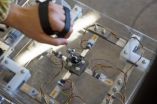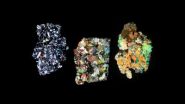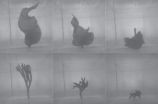(Press-News.org) HOUSTON – (May 9, 2012) – With the aid of multiple force sensors and a digital dinosaur, a team of Rice University seniors known as Helping Hands hopes to restore strength and flexibility to the hands and wrists of children with cerebral palsy.
"These kids have a real problem with their hands," said Jenna Desmarais, a senior at Rice majoring in mechanical engineering. "The fingers and wrists are locked into a sort of claw-like position. Even after surgery to correct it, they need physical therapy to get stronger."
The team's rehabilitation device, the Dino-Might, was inspired by their mentor, Gloria Gogola, a pediatric hand and upper-extremity surgeon at Shriners Hospitals for Children in Houston. She corrects the condition, known as spastic wrist flexion deformity, and restores wrist extension by surgically removing a tendon from the underside of the wrist and attaching it to the upper portion.
After surgery, the wrist and its associated muscles and tendons, though straightened, are weak and must be exercised to restore near-normal use. Gogola wanted a rehabilitation device that securely positions the patient's limb, senses and records its strengths and provides a workout for the weakened wrist. Dino-Might prompts the child to appropriately adjust his or her movements with a computer game starring an animated dinosaur.
Along with Desmarais, the team consists of bioengineering majors Jessica Joyce and Allison Post and mechanical engineering majors Kurt Kienast, Lawrence Lin and Leslie Miller.
"It's a game, essentially, but one that's connected to eight strength gauges," said Joyce, who devised the software for the device. "By playing the game, the child is telling us how strong she is and how well she can use her wrist and hand. With the game as an incentive, we're learning the patient's strong points, keeping a record of them and making them stronger at the same time."
VIDEO:
A team of Rice University engineering students created the Dino-Might to help children with cerebral palsy rehabilitate their wrists and hands.
Click here for more information.
On the display screen, the patient is given an angular route and is asked to follow it as closely as possible. Using a graphical user interface (GUI) and a data acquisition device, the researchers are able to record results of the patient's movements while the results are being displayed in real time.
"There have been similar devices in use, but Dr. Gogola hasn't been satisfied with them," Joyce said. "Something, some feature she wants to use, is always missing. What's novel here is the completeness, all in one package – the force sensors, the arm restraint, the stand, the hand restraint, the GUI."
The team has already tested the device on three patients in Gogola's clinic and used the results to recalibrate the sensors.
"Every time the device is used on a new patient, it's adjusted and customized to fit that individual child," Desmarais said. "The information we're giving Dr. Gogola is accurate for that specific patient. The doctor isn't getting a general idea but a precise picture of that boy or girl."
The device might also be adjusted for use by older patients suffering from stroke and spinal cord injuries. Gogola plans to use it this summer on her pediatric patients and report her findings to the team at Rice.
INFORMATION:
This news release can be found online at http://news.rice.edu/2012/05/09/helping-hands-reaches-out-to-patients-with-cerebral-palsy
Watch a video demonstration of Dino-Might: http://youtu.be/KWBglUDK4X4
Related materials:
Team Helping Hands: http://oedk.rice.edu/Content/Members/MemberPublicProfile.aspx?pageId=1137258&memberId=5469851
George R. Brown School of Engineering: http://engr.rice.edu/
Shriners Hospital for Children in Houston: http://www.shrinershospitalsforchildren.org/Hospitals/Locations/Houston.aspx
Photos for download:
http://news.rice.edu/wp-content/uploads/2012/05/0511_HANDS-1-WEB.jpg
The Dino-Might rehabilitation device invented by students at Rice University is attached to strength gauges that feed data to a computer on which patients play a game while it records their progress. (Credit: Jeff Fitlow/Rice University)
http://news.rice.edu/wp-content/uploads/2012/05/0511_HANDS-2-WEB.jpg
Jenna Demarais tests the Dino-Might, a rehabilitation device for young patients with cerebral palsy that was invented by a team of senior engineering students at Rice University. (Credit: Jeff Fitlow/Rice University)
http://news.rice.edu/wp-content/uploads/2012/05/0511_HANDS-3-WEB.jpg
Rice University engineering senior Jenna Demarais works with the Dino-Might, a rehabilitation device to help young patients with cerebral palsy strengthen their wrists while recording their progress. (Credit: Jeff Fitlow/Rice University)
http://news.rice.edu/wp-content/uploads/2012/05/0511_HANDS-4-WEB.jpg
Rice University engineering students Jenna Demarais, left, and Jessica Joyce work with Dino-Might. The device invented by team Helping Hands, of which they were members, helps patients with cerebral palsy strengthen their wrists while recording their progress. (Credit: Jeff Fitlow/Rice University)
http://news.rice.edu/wp-content/uploads/2012/05/0511_HANDS-5-WEB.jpg
The Dino-Might invented by students at Rice University secures the forearms of young patients with cerebral palsy while helping them rehabilitate their wrists and hands. (Credit: Jeff Fitlow/Rice University)
Located on a 300-acre forested campus in Houston, Rice University is consistently ranked among the nation's top 20 universities by U.S. News & World Report. Rice has highly respected schools of Architecture, Business, Continuing Studies, Engineering, Humanities, Music, Natural Sciences and Social Sciences and is known for its "unconventional wisdom." With 3,708 undergraduates and 2,374 graduate students, Rice's undergraduate student-to-faculty ratio is 6-to-1. Its residential college system builds close-knit communities and lifelong friendships, just one reason why Rice has been ranked No. 1 for best quality of life multiple times by the Princeton Review and No. 4 for "best value" among private universities by Kiplinger's Personal Finance. To read "What they're saying about Rice," go to www.rice.edu/nationalmedia/Rice.pdf.
Helping Hands reaches out to patients with cerebral palsy
Rice University students invent device to strengthen children's hands and wrists
2012-05-11
ELSE PRESS RELEASES FROM THIS DATE:
New twist on ancient math problem could improve medicine, microelectronics
2012-05-11
ANN ARBOR, Mich.—A hidden facet of a math problem that goes back to Sanskrit scrolls has just been exposed by nanotechnology researchers at the University of Michigan and the University of Connecticut.
It turns out we've been missing a version of the famous "packing problem," and its new guise could have implications for cancer treatment, secure wireless networks, microelectronics and demolitions, the researchers say.
Called the "filling problem," it seeks the best way to cover the inside of an object with a particular shape, such as filling a triangle with discs ...
ICU stays for worst asthma drop 74 percent, review finds
2012-05-11
SAN ANTONIO (May 10, 2012) — A review of 30 years of life-threatening asthma cases in a San Antonio intensive care unit found that annual ICU admissions for the condition have dropped 74 percent. The study, by UT Medicine San Antonio physicians who reviewed cases at University Hospital between 1980 and 2010, also showed intubation in the emergency department to help patients breathe did not result in longer hospital stays.
UT Medicine is the clinical practice of the School of Medicine at The University of Texas Health Science Center San Antonio.
Faculty studied inpatient ...
UF study finds logging of tropical forests needn't devastate environment
2012-05-11
GAINESVILLE, Fla. — Harvesting tropical forests for timber may not be the arch-enemy of conservation that it was once assumed to be, according to a new study led by a University of Florida researcher.
Selective logging may be one of the few feasible options left for conserving tropical forests given the huge financial incentives pushing tropical landholders to convert primary forests into cash-generating agricultural plantations.
The report analyzed data from more than 100 studies of tropical forests on three continents that had been harvested for timber. Results ...
CNIO researchers describe a new target for developing anti-angiogenic and anti-tumoral therapies
2012-05-11
Researchers from the Spanish National Cancer Research Centre (CNIO), led by Jorge L. Martínez-Torrecuadrada from the Proteomics Unit, have demonstrated that the antibody-based blocking of ephrinB2, a protein involved in angiogenesis and lymphoangiogenesis, may represent an effective strategy for the development of antiangiogenic and antitumoural therapies.
The results of this study appeared in this month's issue of Blood, the journal of the American Society of Hematology.
CNIO researchers generated highly-specific human antibodies against ephrin-B2 using a phage display ...
Nanotube 'sponge' has potential in oil spill cleanup
2012-05-11
A carbon nanotube sponge that can soak up oil in water with unparalleled efficiency has been developed with help from computational simulations performed at the Department of Energy's (DOE's) Oak Ridge National Laboratory.
Carbon nanotubes, which consist of atom-thick sheets of carbon rolled into cylinders, have captured scientific attention in recent decades because of their high strength, potential high conductivity and light weight. But producing nanotubes in bulk for specialized applications was often limited by difficulties in controlling the growth process as well ...
New report illustrates impact of sequestration to medical research
2012-05-11
The report "Sequestration: Health Research at the Breaking Point," released today by Research!America, demonstrates the damaging consequences of potential automatic spending cuts, or sequestration, to the nation's medical research enterprise and public health, and offers examples on how these cuts would delay scientific discoveries that could lead to new treatments and cures for deadly diseases.
This report provides:
The estimated budget cuts to the National Institutes of Health, the Centers for Disease Control and Prevention, the Agency for Healthcare Research and ...
Dawn reveals complexities of ancient asteroidal world
2012-05-11
TEMPE, Ariz. – New findings from NASA's Dawn spacecraft lay the groundwork for the first geological overview of asteroid (4)Vesta and confirm the existence of not one but two giant impact basins in its southern hemisphere. The findings, published today in a set of Science papers, will help scientists better understand the early solar system and processes that occurred as it formed and evolved.
The Dawn spacecraft, orbiting asteroid Vesta since July 2011, has already acquired several thousand images of the asteroid's surface, revealing a complex landscape. The images ...
Patients see benefits and risks to direct-to-consumer genetics tests
2012-05-11
MAYWOOD, Ill. – Patients see potential benefits from direct-to-consumer genetic testing, but are also concerned about how test results will be used, and generally are unwilling to pay more than $10 or $20 for them, according to focus groups conducted by researchers at Loyola University Chicago Stritch School of Medicine.
Findings by first author Katherine Wasson, PhD, MPH, and colleagues are published in the American Journal of Bioethics Primary Research. Wasson, an assistant professor in Loyola's Neiswanger Institute for Bioethics and Health Policy, is an expert on the ...
New research on seaweeds shows it takes more than being flexible to survive crashing waves
2012-05-11
Seaweeds are important foundational species that are vital both as food and habitat to many aquatic and terrestrial shore organisms. Yet seaweeds that cling to rocky shores are continually at risk of being broken or dislodged from their holds by crashing waves with large hydrodynamic forces. So how do such seaweeds survive in intertidal zones? Do they have special properties that make them extremely flexible or particularly strong?
Patrick Martone (University of British Columbia) has spent a considerable amount of time standing on the shore watching big waves crash ...
You're beautiful, Vesta
2012-05-11
When UCLA's Christopher T. Russell looks at the images of the protoplanet Vesta produced by NASA's Dawn mission, he talks about beauty as much as he talks about science.
"Vesta looks like a little planet. It has a beautiful surface, much more varied and diverse than we expected," said Russell, a professor in UCLA's Department of Earth and Space Sciences and the Dawn mission's principal investigator. "We knew Vesta's surface had some variation in color, but we did not expect the diversity that we see or the clarity of the colors and textures, or their distinct boundaries. ...
LAST 30 PRESS RELEASES:
The Ceramic Society of Japan’s Oxoate Ceramics Research Association launches new international book project
Heart-brain connection: international study reveals the role of the vagus nerve in keeping the heart young
Researchers identify Rb1 as a predictive biomarker for a new therapeutic strategy in some breast cancers
Survey reveals ethical gaps slowing AI adoption in pediatric surgery
Stimulant ADHD medications work differently than thought
AI overestimates how smart people are, according to HSE economists
HSE researchers create genome-wide map of quadruplexes
Scientists boost cell "powerhouses" to burn more calories
Automatic label checking: The missing step in making reliable medical AI
Low daily alcohol intake linked to 50% heightened mouth cancer risk in India
American Meteorological Society announces Rick Spinrad as 2026 President-Elect
Biomass-based carbon capture spotlighted in newly released global climate webinar recording
Illuminating invisible nano pollutants: advanced bioimaging tracks the full journey of emerging nanoscale contaminants in living systems
How does age affect recovery from spinal cord injury?
Novel AI tool offers prognosis for patients with head and neck cancer
Fathers’ microplastic exposure tied to their children’s metabolic problems
Research validates laboratory model for studying high-grade serous ovarian cancer
SIR 2026 delivers transformative breakthroughs in minimally invasive medicine to improve patient care
Stem Cell Reports most downloaded papers of 2025 highlight the breadth and impact of stem cell research
Oxford-led study estimates NHS spends around 3% of its primary and secondary care budget on the health impacts of heat and cold in England
A researcher’s long quest leads to a smart composite breakthrough
Urban wild bees act as “microbial sensors” of city health.
New study finds where you live affects recovery after a hip fracture
Forecasting the impact of fully automated vehicle adoption on US road traffic injuries
Alcohol-related hospitalizations from 2016 to 2022
Semaglutide and hospitalizations in patients with obesity and established cardiovascular disease
Researchers ‘listen in’ to embryo-mother interactions during implantation using a culture system replicating the womb lining
How changing your diet could help save the world
How to make AI truly scalable and reliable for real-time traffic assignment?
Beyond fragmented markets: A new framework for efficient and stable ride-pooling
[Press-News.org] Helping Hands reaches out to patients with cerebral palsyRice University students invent device to strengthen children's hands and wrists


